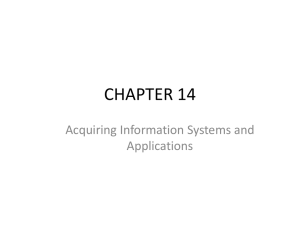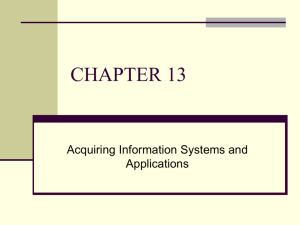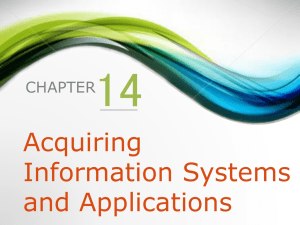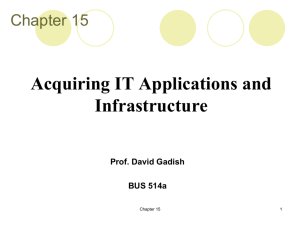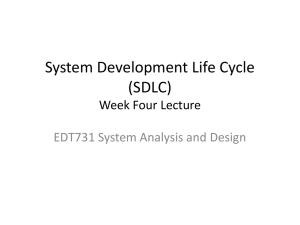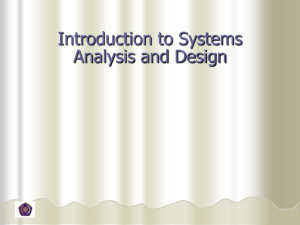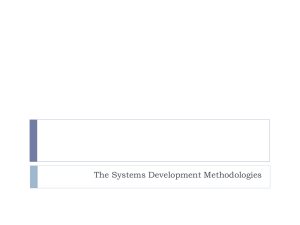ch10v4 - MIS315-05
advertisement
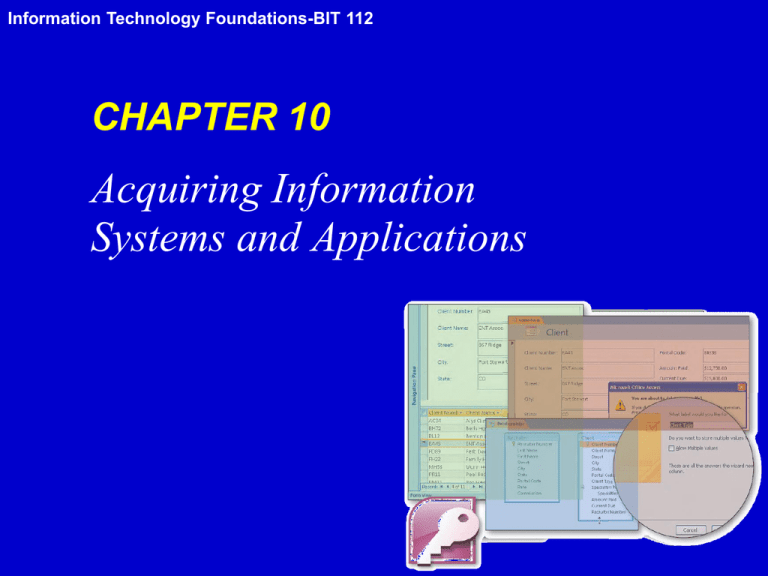
Information Technology Foundations-BIT 112 CHAPTER 10 Acquiring Information Systems and Applications Information Technology Foundations-BIT 112 Chapter Outline • 10.1 Planning for and Justifying IT Applications • 10.2 Strategies for acquiring IT Applications • 10.3 Traditional Systems Development Life Cycle • 10.4 Alternative Methods and Tools for Systems Development • 10.5 Outsourcing and Application Service Providers • 10.6 Vendor and Software Selection 2 Information Technology Foundations-BIT 112 Learning Objectives • Describe the IT planning process. • Describe the IT justification process and methods. • Describe the SDLC and its advantages and limitations. • Describe the major alternative methods and tools for building information systems. • List the major IT acquisition options and the criteria for option selection. • Describe the roles of hosting vendors. • Describe the process of vendor and software selection. 3 Information Technology Foundations-BIT 112 10.1 Planning of and Justifying IT Applications • Organizations must analyze the need for the IT application. • Each IT application must be justified in terms of costs and benefits. • The application portfolio is a prioritized list of both existing and potential IT applications of a company. 5 Information Technology Foundations-BIT 112 Information Systems Planning Process 6 Information Technology Foundations-BIT 112 Information Systems Planning • Organizational strategic plan states the firm’s overall mission, the goals that follow from that mission, and the broad steps necessary to reach these goals. • IT architecture delineates the way an organization’s information resources should be used to accomplish its mission. • Both are inputs in developing the IT Strategic Plan. 7 Information Technology Foundations-BIT 112 IT Strategic Plan • IT Strategic Plan is a set of long-range goals that describe the IT infrastructure and major IT initiatives needed to achieve the goals of the organization. – It must be aligned with the organization’s strategic plan. – It must provide for an IT architecture that enables users, applications and databases to be seamlessly networked and integrated. – It must efficiently allocate IT development resources among competing projects, so that projects can be completed on time and within budget and the have the required functionality. 8 Information Technology Foundations-BIT 112 IT Operational Plan • Consists of a clear set of projects that the IT department and functional area managers will execute in support of the IT strategic plan. • Contains the following elements: – Mission : derived from IT strategy. – IT environment : summary of information needs of the functional areas and of the organization as a whole. – Objectives of the IT function : best current estimate of the goals. – Constraints of the IT function : technological, financial, personnel and other resource limitations. – Application portfolio : prioritized inventory of present applications and a detailed plan of projects to be developed or continued. – Resource allocation and project management : listing of who is going to do what, how and when. 10 Information Technology Foundations-BIT 112 Evaluating & Justifying IT Investment: Benefits, Costs & Issues • Assessing the costs – Fixed costs: are those costs that remain the same regardless of change in the activity level. For IT, fixed costs include infrastructure cost, cost of IT services, and IT management cost – Total cost of ownership (TCO): Formula for calculating cost of acquiring, operating and controlling an IT system. • Assessing the benefits (Values) – Intangible benefits: Benefits from IT that may be very desirable but difficult to place an accurate monetary value on. • Compare and identify issues 11 Information Technology Foundations-BIT 112 10.2 Strategies for Acquiring IT Applications • Buy the applications (off-the-shelf approach) • Lease the applications • Use Open-Source Software • Software-as-a-Service • Developing the applications in-house 13 Information Technology Foundations-BIT 112 14 Information Technology Foundations-BIT 112 Software-as-a-service • A method of delivering software, in which a vendor hosts the applications, and customers access these applications over the Internet. • Cloud Computing • e.g., Google Maps 15 Information Technology Foundations-BIT 112 10.3 Traditional Systems Development Life Cycle • Software Development Life Cycle (SDLC) is the traditional systems development method that organizations use for large-scale IT projects. • SDLC processes are: systems investigation, systems analysis, systems design, programming, testing, implementation, operation and maintenance. • Waterfall approach is when tasks in one phase are completed before the work proceeds to the next stage. 16 Information Technology Foundations-BIT 112 Traditional Systems Development Life Cycle (SDLC) 17 Information Technology Foundations-BIT 112 The Systems Development Life Cycle (SDLC) • Major advantages – Control – Accountability – Error detection • Major drawbacks – Relatively inflexible – Time-consuming and expensive – Discourages changes once user requirements are done 18 Information Technology Foundations-BIT 112 SDLC – 1) Systems Investigation • Begins with the business problem (or opportunity) followed by the feasibility analysis. • Feasibility study – The main task of the Systems Investigation phase. – The feasibility study helps the organization choose between 3 options: • (1) Do nothing and continue to use the existing system unchanged. • (2) Modify or enhance the existing system. • (3) Develop a new system. • Go/No-Go Decision 19 Information Technology Foundations-BIT 112 SDLC – 2) System Analysis • Is the examination of the business problem that the organization plans to solve with an information system. – Users prefer information systems that are oriented toward facilitating organizational tasks and solving business problems • Main purpose is to gather information about existing system to determine requirements for the new or improved system. • Deliverable is a set of system requirements. 21 Information Technology Foundations-BIT 112 SDLC – 3) Systems Design • Describes how the system will accomplish this task. • Deliverable is the Technical Design that specifies: – System outputs, inputs, user interfaces. – Hardware, software, databases, telecommunications, personnel & procedures. – Blueprint of how these components are integrated. • Logical system design states what the system will do, using abstract specifications. • Physical system design states how the system will perform its functions, with actual physical specifications. • Scope creep is caused by adding functions after the project has been initiated. 22 Information Technology Foundations-BIT 112 SDLC – 4) Programming & 5) Testing • Programming involves the translation of a system’s design specification into computer code. • Testing checks to see if the computer code will produce the expected and desired results under certain conditions. • Testing is designed to delete errors (bugs) in the computer code. These errors are of two types: – Syntax errors ( e.g., misspelled word or a misplaced comma) – Logic errors that permit the program to run but result in incorrect output. 23 Information Technology Foundations-BIT 112 SDLC – 6) Systems Implementation • Implementation or deployment is the process of converting from the old system to the new system. • There are four major conversion strategies. – Direct Conversion. Implementation process in which the old system is cut-off and the new system turned on at a certain point in time. – Pilot Conversion. Implementation process that introduces the new system in one part of the organization on a trial basis, when new system is working property, it is introduced in other parts of the organization. – Phased Conversion. Implementation process that introduces components of the new system in stages, until the entire new system is operational. – Parallel Conversion. Implementation process in which the old system and the new system operate simultaneously for a period of time. Rarely used today if at all. 25 Information Technology Foundations-BIT 112 SLDC – 7) Operation & 8) Maintenance • Audits are performed to assess the system’s capabilities and to determine if it is being used correctly. • Systems need several types of maintenance. – Debugging: A process that continues throughout the life of the system. – Updating: Updating the system to accommodate changes in business conditions (a.k.a., minor requirement changes) – New Functionally to the system: Adding new features to the existing system without disturbing its operation. 26 Information Technology Foundations-BIT 112 10.4 Alternative Methods & Tools for Systems Development • • • • • • • • Prototyping – Approach that defines an initial list of user requirements, builds a prototype system and then improves the system in several iterations based on users’ feedback. Joint application design (JAD) – A group–based tool for collecting user requirements and creating system designs. Computer-Assisted Software Engineering (CASE) – Development approach that uses specialized tools to automate many of the tasks in the SDLC; upper CASE tools in SDLC automate the early stages of the SDLC, and lower case tools automate the later stages. Integrated Computer-Assisted Software Engineering (ICASE) Tools – CASE tools that provide links between upper CASE and lower CASE tools. Rapid Application Development (RAD) – Development method that uses special tools and an iterative approach to rapidly produce a highquality system. Agile Development – Development method that delivers functionality in rapid iterations requiring frequent communication, development, testing, and delivery. End-User Development – Development method that has the actual user develop their own application(s) for use. Component-Based Development – Uses standard components to build applications. 27 Information Technology Foundations-BIT 112 Prototyping • Helps clarify user requirements, promotes genuine user participation, and may produce part of the final system? • But, it may encourage inadequate problem analysis, is not practical with large numbers of users, and may result in a system with lower quality. • Order of steps to follow in the project – – – – Identify user requirements; develop the prototype; use the prototype; revise and enhance the prototype 28 Information Technology Foundations-BIT 112 Rapid Application Development (RAD) versus SDLC 29 Information Technology Foundations-BIT 112 10.5 Outsourcing & Application Service Providers • Outsourcing is when an organization acquires IT applications or services from outside contractors or external organizations. • Application Service Provider (ASP) is an agent or vendor who assembles the software needed by enterprises and packages the software with services such as development, operations and maintenance. 30 Information Technology Foundations-BIT 112 10.6 Vendor & Software Selection • Step 1: Identify potential vendors. • Step 2: Determine the evaluation criteria. – This is the most difficult and crucial task . – Request for proposal (RFP) is a document sent to potential vendors to submit a proposal describing their software package and explain how it would meet the company’s needs. • Step 3: Evaluate vendors and packages. 32 Information Technology Foundations-BIT 112 Vendor & Software Selection (continued) • Step 4: Choose the vendor and package. • Step 5: Negotiate a contract. • Step 6: Establish a service level agreement. – Service Level Agreements (SLAs) are formal agreements that specify how work is to be divided between the company and its vendors. 33
